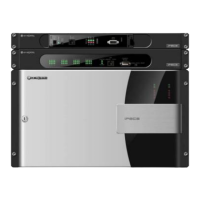
Do you have a question about the LG IPECS and is the answer not in the manual?
| VoIP Support | Yes |
|---|---|
| SIP Support | Yes |
| Humidity | 10% to 90% non-condensing |
| Maximum Trunks | Varies by model |
| Maximum Extensions | Varies by model |
| Ports | Varies by model |
| Protocols | SIP, H.323 |
| Dimensions | Varies by model |
| Operating Temperature | 0°C to 40°C |
| Power Supply | Internal, AC power |
Equipment complies with FCC, IC, UL, CSA, EN standards.
Details feature description and operation of iPECS Release 5 software.
Outlines the configurations and port capacities of the iPECS Series.
Allows tracking of specific calls using a variable identifier for output in SMDR.
Incorporates call routing, agent monitoring, supervision, and statistics for call centers.
Enables users to reroute incoming calls to other stations or groups.
Flex button assigned as DSS/BLF indicates station status.
Enables non-blocking intercom calls to any station via dialing digits or DSS/BLF buttons.
Automatically places CO lines in Out-of-Service state during faults and restores them.
Allows incoming callers to access system resources via dial codes.
Notifies user of voice mailbox calls and allows call screening.
Retries busy or unanswered external calls until connected or feature cancelled.
Establishes routing scenarios for incoming calls based on time, day, and caller ID.
Allows another attendant to answer calls when the primary attendant station is unavailable.
Codes used by attendants for printing reports, assigning codes, and managing features.
Alerts attendant to faults in cabinet fans or power supplies.
Allows SLT users to engage in two private calls, alternating between parties.
Allows SLT users to program names for display instead of station numbers.